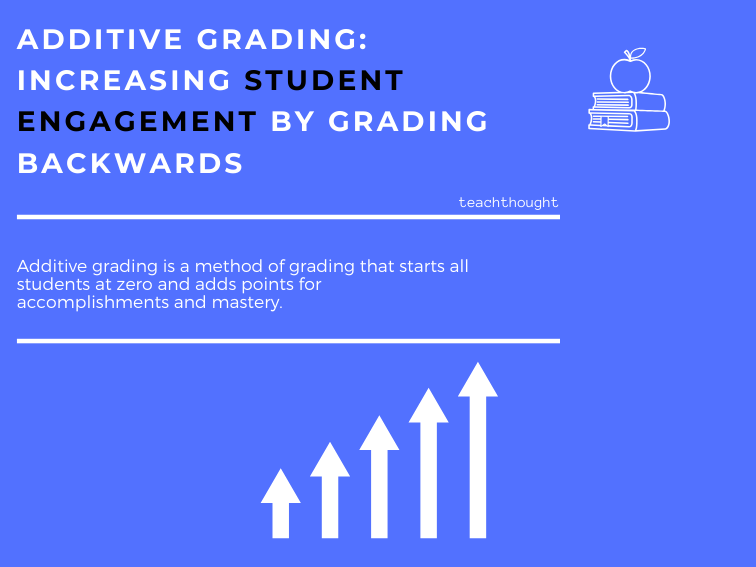What Is Additive Grading? Increasing Student Engagement By Grading Backwards
Engagement is not an on/off switch. Minds engage in degrees, and without meaningful engagement, learning stalls. Additive grading—sometimes described as ‘grading backwards’—reverses the usual pattern: instead of losing points from a perfect score, students start at zero and earn points through progress and mastery.
At a glance
- Definition: Students begin at zero and earn points for successful work and demonstrated mastery.
- Why it matters: Encourages risk-taking, iteration, and problem solving—core conditions for genuine engagement.
- Different from traditional grading: Shifts from a subtractive model (lose points) to an additive model (gain points); aligns with game-like progression.
The problem with subtractive grading
In many classrooms, students begin with a 100 and lose points for anything less than perfect. This subtractive system can discourage experimentation and creativity: when trying, failing, and revising risks a lower score, students learn to avoid risk.
Because grades drop with mistakes, learners are nudged toward narrow compliance—doing exactly what is shown—rather than reasoning flexibly or testing alternative approaches.
See also 12 Smart Ideas To Grade Essays Faster
Why additive grading changes the logic
Well-designed games rarely subtract progress for trying. Players start at zero and earn points, experience, or levels for actions that show skill. Failure is permitted and expected; repeated attempts are part of learning the system. Additive grading borrows that logic for classrooms.
Under an additive system, each successful demonstration of understanding adds to the total. Students see a visible path forward: if they want more points, they must produce more evidence of learning. That framing promotes persistence.
Mastery-based progression and pacing
Games gate progress until prior skills are mastered; the next challenge builds on the last. In classrooms, mastery-based progression can work similarly. Students move to the next objective when they demonstrate competency on the current one, not when the calendar turns.
This approach supports different pacing needs. Students who grasp a concept quickly can advance, while those who need more time can practice and retry without penalty for initial attempts.
See also Examples of Analogies for Critical Thinking
Implementing additive grading (starter moves)
- Start at zero, then share: Share a clear points map (e.g., 900–1000 = A, 800–899 = B).
- Define evidence of learning: Identify the specific performances (tasks, problems, products) that earn points.
- Allow revision: Permit resubmissions to ‘earn up’ to the desired level; require students to annotate changes.
- Use objective checks for mastery: Short assessments confirm readiness to move on.
- Balance task variety: Mix low-stakes practice with higher-value demonstrations to reward growth.
- Track progress visibly: Use periodic summaries to show progress over time.
A classroom example: earning an A
Game designer and professor Lee Sheldon famously structures courses so students start with zero points and earn their way to a target grade. If a submission falls short, students can revise or complete additional work to add points toward their goal. The emphasis is on earning, not protecting, a score.
Common challenges (and simple mitigations)
Grade conversations: Students new to the model may worry about ‘starting at zero.’ Solution: publish the ladder, show typical weekly point gains, and celebrate incremental progress.
Time and feedback: Revision takes time. Solution: use concise rubrics, structured peer review, and brief mastery checks to keep cycles short.
Alignment with reporting systems: Many gradebooks assume percentages. Solution: map cumulative points to conventional letter bands and keep the reporting simple.
Conclusion
Additive grading reframes assessment as progress rather than loss. By rewarding evidence of learning and permitting iteration, it encourages risk-taking, supports individualized pacing, and strengthens engagement—the conditions under which thinking actually improves.
Quick FAQ
Is additive grading the same as ‘no grades’? No. It still produces a final grade; it simply changes how points are earned.
Does it inflate grades? Not if the point map and evidence standards are clear and consistent.
Will students still try hard? Typically yes—earning feels fair and progress is visible, which sustains effort.
Related resources
For practical strategies, see Examples of Essential Questions.Stay ahead with critical thinking insights
Join thousands of educators who receive our free weekly newsletter packed with strategies, tools, and research-based ideas you can use right away.
Research & Sources
- Sheldon, L. (2011). The Multiplayer Classroom: Designing Coursework as a Game. Cengage Learning.
- Willingham, D. (2019). Why Don’t Students Like School? Jossey-Bass.
